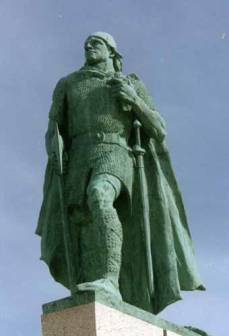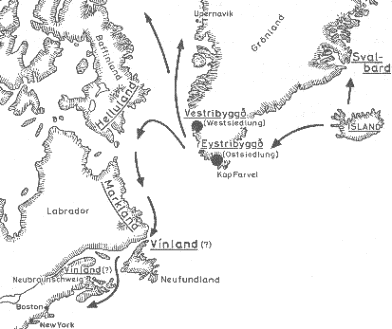Leif
Ericson, ~970/~1020
The
first European to arrive in America
 It
is commonly believed that Christopher Columbus was the first European to arrive
in the New World in 1492.
Indeed, Columbus marks the starting point of the
mass migration of Europeans to America. However, he was not the first European
to set foot in the New World. That happened during the Viking age, 500 years
earlier, when Leif Ericson explored new lands west of Greenland in the year 1000
AD.
It
is commonly believed that Christopher Columbus was the first European to arrive
in the New World in 1492.
Indeed, Columbus marks the starting point of the
mass migration of Europeans to America. However, he was not the first European
to set foot in the New World. That happened during the Viking age, 500 years
earlier, when Leif Ericson explored new lands west of Greenland in the year 1000
AD.
Leif Ericson,
first
European to arrive in America
(Statue
in Reykjavik, Iceland)
Leif "the lucky" Ericson (*)
was
the
second son of Eric "the Red" Thorvaldson, a Norwegian exiled in
Iceland who was the first European to colonize Greenland. Leif was born in
Iceland, but moved to Greenland with his family after his father created a
settlement there. From Greenland, Leif sailed to the west looking for new land
and reached the eastern coast of Canada.
Some families
followed
Leif's route and settled
in America temporarily. However, Greenland was at the time a very remote,
isolated, scarcely populated colony of Icelanders. Interest on further
exploration to the west was eventually lost and Leif's discovery of a far away
land remained unknown in most of Europe. The colonization of Greenland and the
exploration of America are described in the "Saga of Eric the Red" and
the "Saga of the Greenlanders", both written around the year 1200.
Leif Ericson was officially recognized to be the
first European to set foot in America when, almost 1000 years after his death,
the Icelandic Sagas were re-discovered and a Norse settlement was found in
L'Anse aux Meadows, Canada. In 1964, United States president Lyndon B. Johnson
declared the 9th of October to be "Leif Ericson Day" in commemoration
of the first arrival of a European to North America. In the year 2000,
celebrations were organized in North America, Greenland and Europe to
commemorate the 1000th anniversary of Leif Ericson's exploration of the New
World.
Leif's life in Iceland and settlement
in Greenland
Little is known of Leif Ericson's early years. He
was the second of the three sons of Eric "the Red", a violent man who
had been exiled from Norway to Iceland. Leif was probably born in Eiríksstadir,
Iceland, between 960-980 AD. He was raised and educated by Tyrkir, a German that
his father Eric had captured during a Viking trip.
When Leif was a young boy, his father Eric was
banished three years from Iceland for killing a man during a dispute. Unable to
return to Norway and now banished from Iceland, Erik took his family and sailed
westward following reports of a new land off the coast of Iceland. The reports
were true and Eric the Red reached a cold, rough land of glaciers and icebergs.
He purposely called it "Greenland", hoping that this motivating name
would attract other colonists. Eric became the first European to settle
permanently in Greenland.
Leif and his family lived entirely isolated in
Greenland for three years. After the end of his three years banishment, Eric the
Red returned to Iceland looking for people to settle in his "Green
Land". In the summer of 985, Eric set out with 25 ships loaded with
Icelandic colonists, but the weather was treacherous and only 14 ships and about
350 settlers managed to make the crossing. This was the beginning of the first
European settlement of Greenland, which would last for over 400 years.
Leif Ericson had acquired great experience as a
seaman and explorer during all this time, and at the age of 20 he set off with a
crew of fourteen men to Norway, where his family was originally from. According
to the Saga of Eric the Red, his ship first stopped in the Hebrides Isles,
Scotland, where he was a guest of the lord of the island and married his
daughter, Thorgunna.
In Norway, Leif Ericson was invited to stay for
the winter as a guest of King Olaf Tryggvasson. King Olaf, a converted Christian
himself, convinced Leif to become a Christian, and he further commissioned him
to bring a priest back to Greenland to spread Christianity there.
Leif
Ericson's arrival to North America
 The discovery of new lands on the eastern coast
of North America is recorded in the Saga of Eric the Red and in the Saga of the
Greenlanders, written in Iceland around the year 1200. The Sagas relate how
Bjarni Herjolfsson was the first to report new land west of Greenland, and how
Leif Ericson explored them and stayed there for the winter.
The discovery of new lands on the eastern coast
of North America is recorded in the Saga of Eric the Red and in the Saga of the
Greenlanders, written in Iceland around the year 1200. The Sagas relate how
Bjarni Herjolfsson was the first to report new land west of Greenland, and how
Leif Ericson explored them and stayed there for the winter.
The Saga of the Greenlanders tells that on his
return to Greenland, Leif Ericson met a sailor called Bjarni Herjolfsson.
Herjolfsson told Leif how his ship got lost in the ocean after been driven far
off course by a storm, and affirmed sighting a green, forested land which was
not Greenland because it had no glaciers or fjords. Herjolfsson is considered to
be the first European to have spotted North America, possibly the coast of Nova
Scotia.
Ericson got very interested in Bjarni's story and
he decided set off on an expedition with a crew of 35 men in the year 1000 AD.
Leif soon found a new land that he called Helluland, the flat and stony
land, thought to have been Baffin Island or Labrador. From there, Leif's
expedition continued sailing south along the coast and stopped in a second land
he called Markland, the wood land, believed to have been Newfoundland.
The expedition sailed further to the south, possibly as far as Cape Cod, and
stopped in a land that the Sagas describe as rich, fertile, and forested,
where grapes grow... Leif called it Vinland, the wine land. He and
his men spent the winter in Vinland, filled his ship with the riches of the new
land, and returned to Greenland in the spring.
The first European settlement in
North America
On his arrival to Greenland, Leif became known as
"Leif the Lucky" because he had found great wealth and no troubles
during his expedition to Vinland. Eric the Red died one year after his son's
return from Vinland, so Leif took over his father's farm of Brattahlid and never
travelled again.
Leif's brother, Thorvald Ericson, organized a
second expedition to Vinland two years after Leif's journey. While exploring the
new land, Thorvald was killed in a violent clash with a group of native North
Americans. Thorvald Ericson became the first European to die and to be buried in
America.
Leif's reports of fertile Vinland reached as far
as Iceland, and a colonist expedition composed by sixty men and five women was
organized by Thorfinn Karlsefni. The group led by Thorfinn settled in Vinland
for about three years. It is thought that they were probably driven away by
violent encounters with the Skraelings, a Norse word for the native North
Americans. During their time in Vinland, Thorfinn and his wife Gudrid had a son,
Snorri, who was first European child to be born in America.
Eventually, the Norse colony in Vinland was
abandoned and Thorfinn, Gudrid and Snorri returned to Iceland. It is believed
that the Greenlanders returned to Vinland on many occasions before the Greenland
colony disappeared in the 14th-15th century. Very little is known about Leif
Ericson's later life. The Saga of Eric the Red and the Saga of the Greenlanders
tell that after his journey to Vinland, Leif became the most prominent person in
Greenland. He was well respected and lived and died at Brattahlid.
The Viking World Heritage Site in
L'Anse aux Meadows, Canada
Almost one thousand years after the Norse
explored Vinland, scholars and historians re-discovered the Sagas and learn
about the expeditions of Leif Ericson and other Norse to America. Archaeologists
started looking for proof of Norse presence on the Eastern coast of North
America and in 1960 Norwegian explorer Helge Ingstad unveiled the remains of a
European settlement in L' Anse aux Meadows, Newfoundland, Canada.
Helge and a group of Scandinavian and American
archaeologists discovered a Norse settlement with eight buildings and important
archaeological remains. The excavations of the settlement have helped us to
known that L'Anse aux Meadows was used as a base between Greenland and Vinland,
which according to the descriptions in the Sagas would be situated south of the
Gulf of St. Lawrence.
In 1976 the Norse settlement at L' Anse aux
Meadows was declared an Historic Site in Canada and in 1978 it was declared a
World Heritage Site by the UNESCO, the United Nations. Since then, thousands of
tourists and historians have visited the Viking World Heritage Site, which shows
the reconstructions of three Norse buildings and various exhibits highlighting
the lifestyle in the earliest European settlement in the New World.
Spelling note:
(*) There are several different
spellings for the name of Leif Ericson - Leiv, Erikson, Eriksson or Ericsson. In
Icelandic, his name is written as Leifur Eiríksson. His father's name, Eric
Thorvaldson, is also spelled as Erik, Eirík Thorvaldsson and Eiríkur Ţorvaldsson
in Icelandic.
Do you want to know more?
Visit the website of Parks
Canada - The Viking World Heritage Site at L'Anse aux Meadows, the earliest European
settlement in the New World.
http://www.pc.gc.ca/lhn-nhs/nl/meadows/index_e.asp
The two famous Icelandic sagas describing the discovery
of both Greenland and North America:
Graenlendinga
Saga and Eirik's Saga
 It
is commonly believed that Christopher Columbus was the first European to arrive
in the New World in 1492.
Indeed, Columbus marks the starting point of the
mass migration of Europeans to America. However, he was not the first European
to set foot in the New World. That happened during the Viking age, 500 years
earlier, when Leif Ericson explored new lands west of Greenland in the year 1000
AD.
It
is commonly believed that Christopher Columbus was the first European to arrive
in the New World in 1492.
Indeed, Columbus marks the starting point of the
mass migration of Europeans to America. However, he was not the first European
to set foot in the New World. That happened during the Viking age, 500 years
earlier, when Leif Ericson explored new lands west of Greenland in the year 1000
AD. The discovery of new lands on the eastern coast
of North America is recorded in the Saga of Eric the Red and in the Saga of the
Greenlanders, written in Iceland around the year 1200. The Sagas relate how
Bjarni Herjolfsson was the first to report new land west of Greenland, and how
Leif Ericson explored them and stayed there for the winter.
The discovery of new lands on the eastern coast
of North America is recorded in the Saga of Eric the Red and in the Saga of the
Greenlanders, written in Iceland around the year 1200. The Sagas relate how
Bjarni Herjolfsson was the first to report new land west of Greenland, and how
Leif Ericson explored them and stayed there for the winter.